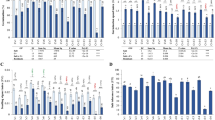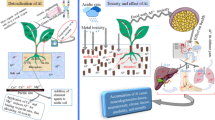Abstract
Aim
A major limitation to plant growth in acid soils is the prevalence of toxic Al3+. Most genotypic variation for acid soil-tolerance in wheat is linked with the Al3+-activated efflux of malate anions from roots which is controlled by TaALMT1 on chromosome 4DL. Recent studies have also linked TaALMT1 with tolerance to high pH solutions and alkaline soils. This study tested the hypothesis that an Al3+-resistant allele of TaALMT1 also confers tolerance to alkaline conditions.
Methods
The near-isogenic wheat lines, ET8 (Al3+-resistant) and ES8 (Al3+-sensitive), have different alleles of the TaALMT1 gene and contrasting resistance to Al3+ toxicity. Growth of these lines was compared in acid and alkaline soils with contrasting mineralogy and in a range of high pH hydroponic solutions of varying composition.
Results
No consistent differences in root or shoot growth were detected between the lines in the alkaline soils or in the high pH hydroponic treatments. Malate efflux was detected from ET8 in acidic solution with Al3+ but no substantial malate efflux was detected at pH 9.0 treatment with added Na2SO4.
Conclusion
The results are inconsistent with the hypothesis that the TaALMT1 gene confers an advantage to wheat on alkaline soils.








Similar content being viewed by others
References
Adcock D, McNeill AM, McDonald GK, Armstrong RD (2007) Subsoil constraints to crop production on neutral and alkaline soils in south-eastern Australia: a review of current knowledge and management strategies. Aust J Exp Agric 47:1245–1261. https://doi.org/10.1071/ea06250
Brautigan D, Rengasamy P, Chittleborough D (2012) Aluminium speciation and phytotoxicity in alkaline soils. Plant Soil 360:187–196
Delhaize E, Craig S, Beaton CD, Bennet RJ, Jagadish VC, Randall PJ (1993) Aluminum tolerance in wheat (Triticum aestivum L.). 1. Uptake and distribution of aluminum in root apices. Plant Physiol 103:685–693
Delhaize E, Gruber BD, Ryan PR (2007) The roles of organic anion permeases in aluminium resistance and mineral nutrition. FEBS Lett 581:2255–2262. https://doi.org/10.1016/j.febslet.2007.03.057
Delhaize E, Ma JF, Ryan PR (2012) Transcriptional regulation of aluminium tolerance genes. Trends Plant Sci 17:341–348. https://doi.org/10.1016/j.tplants.2012.02.008
Delhaize E, Ryan PR, Randall PJ (1993) Aluminum tolerance in wheat (Triticum aestivum L.). 2. Aluminum-stimulated excretion of malic acid from root apices. Plant Physiol 103:695–702
Dolling P, Moody P, Noble I, Helyar K, Hughes B, Reuter D, Sparrow L (2001) Soil acidity and acidification in Australia. National Land and Water Resources Audit Project Report, Canberra
Eagles HA, Cane K, Trevaskis B, Vallance N, Eastwood RF, Gororo NN, Kuchel H, Martin PJ (2014) Ppd1, Vrn1, ALMT1 and Rht genes and their effect on grain yield in lower rainfall environments in southern Australia. Crop Pasture Sci 65:159–170
Foy CD (1984) Physiological effects of hydrogen, aluminum, and manganese toxicities in acid soil. In: Adams F (ed) Soil acidity and liming. American Society of Agronomy, Crop Science Society, American Society of Soil Science, Madison
Furukawa J, Yamaji N, Wang H, Mitani N, Murata Y, Sato K, Katsuhara M, Takeda K, Ma JF (2007) An aluminum-activated citrate transporter in barley. Plant Cell Physiol 48:1081–1091. https://doi.org/10.1093/pcp/pcm091
Gassmann W, Schroeder JI (1994) Inwardly-rectifying K+ channels in roots hairs of wheat - a mechanism for aluminum-sensitive low-affinity K+ uptake amd membrane potential control. Plant Physiol 105:1399–1408
Helyar KR (1991) The management of acid soils. In: Wright RJ (ed) Plant-soil interactions at low pH. p 365-382. Kluwer Academic, Dordrecht
Jefferies SP, Pallotta MA, Paull JG, Karakousis A, Kretschmer JM, Manning S, Islam A, Langridge P, Chalmers KJ (2000) Mapping and validation of chromosome regions conferring boron toxicity tolerance in wheat (Triticum aestivum). Theor Appl Genet 101:767–777
Kochian LV (1995) Cellular mechanisms of aluminum toxicity and resistance in plants. Annu Rev Plant Physiol Plant Mol Biol 46:237–260
Kochian LV, Pineros MA, Liu J, Magalhaes JV (2015) Plant Adaptation to Acid Soils: The Molecular Basis for Crop Aluminum Resistance. Annu Rev Plant Biol 66:571–598. https://doi.org/10.1146/annurev-arplant-043014-114822
Liao M, Hocking PJ, Dong B, Delhaize E, Richardson AE, Ryan PR (2008) Variation in early phosphorus-uptake efficiency among wheat genotypes grown on two contrasting Australian soils. Aust J Agric Res 59:157–166. https://doi.org/10.1071/ar06311
Liu J, Xu M, Estavillo G, Delhaize E, White RM, Zhou M, Ryan PR (2017) OsALMT4 encodes a malate-permeable anion channel in rice (Oryza sativa L.) which is expressed widely and required for normal growth in low light. Plant Physiol (submitted)
Ma JF, Ryan PR, Delhaize E (2001) Aluminium tolerance in plants and the complexing role of organic acids. Trends Plant Sci 6:273–278
Magalhaes JV, Liu J, Guimaraes CT, Lana UGP, Alves VMC, Wang YH, Schaffert RE, Hoekenga OA, Pineros MA, Shaff JE, Klein PE, Carneiro NP, Coelho CM, Trick HN, Kochian LV (2007) A gene in the multidrug and toxic compound extrusion (MATE) family confers aluminum tolerance in sorghum. Nat Genet 39:1156–1161. https://doi.org/10.1038/ng2074
McDonald GK, Taylor JD, Verbyla A, Kuchel H (2013) Assessing the importance of subsoil constraints to yield of wheat and its implication for yield improvement. Crop Pasture Sci 63:1043–1065
Millar AL, Rathjen AJ, Cooper DS (2007) Genetic variation for subsoil toxicities in high pH soils. In: Buck HT, Nisi JE, Salomon N (eds) Wheat production in stressed environments. Springer, Dordrecht
Nable RO, Banuelos GS, Paull JG (1997) Boron toxicity. Plant Soil 193:181–198
Pallotta M, Schnurbusch T, Hayes J, Hay A, Baumann U, Paull J, Langridge P, Sutton T (2014) Molecular basis of adaptation to high soil boron in wheat landraces and elite cultivars. Nature 514:88. https://doi.org/10.1038/nature13538
Paull JG, Rathjen AJ, Cartwright B (1991) Major gene control of tolerance of bread wheat (Triticum aestivum L.) to high concentrations of soil boron. Euphytica 55:217–228
Pereira JF, Zhou G, Delhaize E, Richardson T, Ryan PR (2010) Engineering greater aluminium resistance in wheat by over-expressing TaALMT1. J Exp Bot 106:205–214
Pineros M, Tester M (1993) Plasma-membrane Ca2+ channels in roots of higher roots and their role in aluminum toxicity. Plant Soil 156:119–122
Raman H, Ryan PR, Raman R, Stodart BJ, Zhang K, Martin P, Wood R, Sasaki T, Yamamoto Y, Mackay M, Hebb DM, Delhaize E (2008) Analysis of TaALMT1 traces the transmission of aluminum resistance in cultivated common wheat (Triticum aestivum L.) Theor Appl Genet 116:343–354. https://doi.org/10.1007/s00122-007-0672-4
Raman H, Zhang KR, Cakir M, Appels R, Garvin DF, Maron LG, Kochian LV, Moroni JS, Raman R, Imtiaz M, Drake-Brockman F, Waters I, Martin P, Sasaki T, Yamamoto Y, Matsumoto H, Hebb DM, Delhaize E, Ryan PR (2005) Molecular characterization and mapping of ALMT1, the aluminium-tolerance gene of bread wheat (Triticum aestivum L.) Genome 48:781–791
Ramesh SA, Tyerman SD, Xu B, Bose J, Kaur S, Conn V, Domingos P, Ullah S, Wege S, Shabala S, Feijo JA, Ryan PR, Gilliham M (2015) GABA signalling modulates plant growth by directly regulating the activity of plant-specific anion transporters. Nat Commun 6. doi: https://doi.org/10.1038/ncomms8879
Reid RJ (2007) Identification of boron transporter genes likely to be responsible for tolerance to boron toxicity in wheat and barley. Plant Cell Physiol 48:1673–1678
Ryan PR, Delhaize E (2010) The convergent evolution of aluminium resistance in plants exploits a convenient currency. Funct Plant Biol 37:275–284. https://doi.org/10.1071/fp09261
Ryan PR, Delhaize E, Randall PJ (1995) Characterization of Al-stimulated efflux of malate from the apices of Al-tolerant wheat roots. Planta 196:103–110
Ryan PR, Raman H, Gupta S, Sasaki T, Yamamoto Y, Delhaize E (2010) The multiple origins of aluminium resistance in hexaploid wheat include Aegilops tauschii and more recent cis mutations to TaALMT1. Plant J 64:446–455. https://doi.org/10.1111/j.1365-313X.2010.04338.x
Ryan PR, Shaff JE, Kochian LV (1992) Aluminum toxicity in roots: Correlation between ionic currents, ion fluxes and root elongation in Al-tolerant and Al-sensitive wheat cultivars. Plant Physiol 99:1193–1200
Sasaki T, Ryan PR, Delhaize E, Hebb DM, Ogihara Y, Kawaura K, Noda K, Kojima T, Toyoda A, Matsumoto H, Yamamoto Y (2006) Sequence upstream of the wheat (Triticum aestivum L.) ALMT1 gene and its relationship to aluminum resistance. Plant Cell Physiol 47:1343–1354. https://doi.org/10.1093/pcp/pcl002
Sasaki T, Yamamoto Y, Ezaki B, Katsuhara M, Ahn SJ, Ryan PR, Delhaize E, Matsumoto H (2004) A wheat gene encoding an aluminum-activated malate transporter. Plant J 37:645–653. https://doi.org/10.1111/j.1365-313X.2003.01991.x
Strom L, Owen AG, Godbold DL, Jones DL (2005) Organic acid behaviour in a calcareous soil implications for rhizosphere nutrient cycling. Soil Biol Biochem 37:2046–2054. https://doi.org/10.1016/j.soilbio.2005.03.009
Sutton T, Baumann U, Hayes J, Collins NC, Shi BJ, Schnurbusch T, Hay A, Mayo G, Pallotta M, Tester M, Langridge P (2007) Boron-toxicity tolerance in barley arising from efflux transporter amplification. Science 318:1446–1449. https://doi.org/10.1126/science.1146853
Tang C, Nuruzzaman M, Rengel Z (2003) Screening wheat genotypes for tolerance of soil acidity. Aust J Agric Res 54:445–452. https://doi.org/10.1071/ar02116
Tang C, Rengel Z, Diatloff E, Gazey C (2003) Responses of wheat and barley to liming on a sandy soil with subsoil acidity. Field Crop Res 80:235–244. https://doi.org/10.1016/s0378-4290(02)00192-2
Zheng SJ (2010) Crop production on acidic soils: overcoming aluminium toxicity and phosphorus deficiency. Ann Bot 106:183–184
Zhou GF, Delhaize E, Zhou MX, Ryan PR (2013) The barley MATE gene, HvAACT1, increases citrate efflux and Al3+ tolerance when expressed in wheat and barley. Ann Bot 112:603–612. https://doi.org/10.1093/aob/mct135
Acknowledgements
The authors are grateful to Glenn McDonald, Rhiannon Schilling, Ian Richter and Naomi Scholz for providing alkaline soils from South Australia. We thank Kumara Weligama for assistance in characterizing the soils. Carolina Silva’s research was supported by the São Paulo Research Foundation (Fapesp) in Brazil.
Author information
Authors and Affiliations
Corresponding author
Additional information
Responsible Editor: Jian Feng Ma
Rights and permissions
About this article
Cite this article
Silva, C.M.S., Zhang, C., Habermann, G. et al. Does the major aluminium-resistance gene in wheat, TaALMT1, also confer tolerance to alkaline soils?. Plant Soil 424, 451–462 (2018). https://doi.org/10.1007/s11104-017-3549-6
Received:
Accepted:
Published:
Issue Date:
DOI: https://doi.org/10.1007/s11104-017-3549-6




